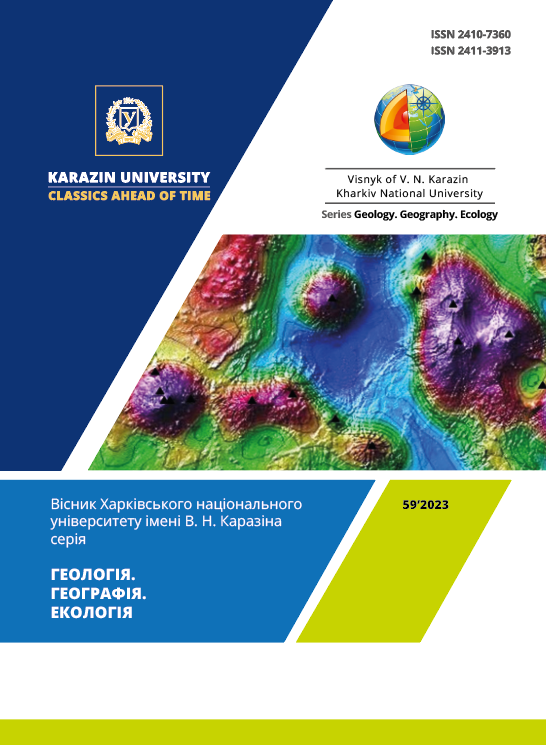Study of crimes in the city of Kokand using GIS technologies and sociological questionnaires
Abstract
Formulation of the problem. It is known that the influence of the demographic, social and economic conditions of the region on criminal activity is significantly high. In this place, researching the types of crime characteristic of cities with different functions, and identifying hotspots where criminal activity has intensified within the city will further enrich the scientific and practical aspects of the geography of crime. The use of geographic information systems (hereinafter GIS) in the implementation of these tasks is an important issue on the agenda of the field today.
Analysis of recent research and publications. Today, in most developed countries, GIS is widely used to identify common crime areas and organize preventive measures for crime prevention. Research in this regard is almost undeveloped in the Republic of Uzbekistan.
Formulation of the purpose of the article. In this study, theft and drug-related crimes committed in the city of Kokand, Fergana region, were investigated using the Hot Spot analysis method of the Arc GIS (version 10.8) program. The problems of combating crime in identified theft and drug-related crime centres were studied with the help of sociological surveys (conducted with prevention inspectors) and an action plan for crime prevention was developed.
Presentation of the main research material. The indicators of crime levels in the small administrative areas of Kokand, in the Fergana region, have been examined in this study. In addition to the types of crimes that are most commonly committed in large social infrastructures (for example, markets, parks, public places) and their specific characteristics, we also discussed the levels of these types of crimes according to age, gender and population size.
Problems and prospects of the development of crime geography in Kokand city. Hotspot analysis consists of identifying hotbeds of crime in the area and developing proposals and recommendations based on this.
Proposals and recommendations for reducing crime in the city of Kokand. First, this technology is effective in identifying crime trends, organizing preventive measures, planning crime prevention strategies, and improving public safety. Second, GIS is adapted for data processing, mapping, and spatial analysis, thereby increasing the effectiveness of crime analysis and quickly creating a quality criminal analysis map. Thirdly, according to the results of this technology, optimization of the distribution of law enforcement officers, proper and planned deployment, and development of more effective crime reduction measures will help.
Downloads
References
The Global Organized Crime Index 2023. https://globalinitiative.net/analysis/ ocindex-2023/
Jayathilaka, T. Wijeratne, S. (2018). Examine the spatial and temporal pattern of crime incidence in an urban environment using geographical information systems. The 39th Asian Conference on Remote Sensing 2018. 112-120.
Socio-economic situation of the Republic of Uzbekistan (2023). Statistics Agency under the President of the Republic of Uzbekistan. Tashkent. 519. https://stat.uz/uz/default/choraklik-natijalar/21516-2022#yanvar-dekabr
It was taken from a video selector meeting in the city of Fergana on July 28, 2023, under the chairmanship of President Shavkat Mirziyoyev, regarding the priority tasks of preventing violations and fighting crime in the regions. Source: https://t.me/Press_Secretary_Uz/3239
Makhmudov Bakhodirjon Khakimjon ogli (2023). Types of Criminality and their Territorial Differences (in the example of Kokand City). Nat Sci, 21(5):1-6. ISSN 1545 0740(print); ISSN 2375-7167(online). doi: https://doi.org/10.7537/marsnsj210523.01
Harries, K. (1999) Mapping Crime: Principle and Practice. US Department of Justice, Washington DC: National Institute of Justice.
Eck, J., Chainey, S., Cameron, J., Leitner, M., & Wilson, R. (2005). Mapping Crime:Understanding Hotspots. U.S. Department of Justice, National Institute of Justice, Washington.
Nazarov M.I. (2006). Giyohvandlikni ijtimoiy hodisa sifatida tadqiq etishning ayrim geografik jihatlari. Tashkent, 183–184.
Gabiani, A.A. (1990). On the edge of the abyss: drug addiction and drug addicts. M.: Mysl.
Chainey, S.P. and Ratcliffe, J.H. (2005). GIS and Crime Mapping. London: John Wiley & Sons, Inc.
Chainey, S. P. (2021). Understanding crime: Analyzing the geography of crime. Esri Press.
Komilova, N., Latipov, N. (2022). Classification of settlements on the basis of the ecological situation in the Navoi region and the factors affecting the health of the population. Visnyk of V. N. Karazin Kharkiv National University, series "Geology. Geography. Ecology”, (56), 209-213. https://doi.org/10.26565/2410-7360-2022-56-15
Karshibaevna, K. N., Kahramonovna, Z. D., & Normurod Faxriddino'g'li, L. (2022). Some problems with creating a medical-geographical atlas map of Uzbekistan. nternational Journal of Early Childhood Special Education (INT-JECSE), 14, 02. doi: https://doi.org/10.9756/int-jecse/v14i2.656
Abdumajidov F.A and Q.R.Abdurasulova etc. (2003). Yuridik atamalar qomusiy lugʻati. Tashkent: Sharq.
Dáire McGill (2017). Different Violence, Different Justice? Taking Structural Violence Seriously in Post-Conflict and Transitional Justice Processes. State Crime Journal. 6(1):79-101. DOI: https://doi.org/10.13169/statecrime.6.1.0079
Neve Gordon and Penny Green (2021). State Crime, Structural Violence and COVID-19. State Crime Journal. 10(1):4-15. DOI: https://doi.org/10.13169/statecrime.10.1.0004
Long, Dongping and Xu, Ming'en and Liu, Lin (2023). Spatio-temporal evolution and regional types of China s sales-based counterfeit drug crimes. Progress in Geography, 42 (5), 944–959. doi: https://doi.org/10.18306/dlkxjz.2023.05.009
Christophe, V and Wim, B.(2017). The geography of crime and crime control. Applied Geography. 86, 220-225. doi: https://doi.org/10.1016/j.apgeog.2017.08.012
Zhe Li, Tianfan Zhang, Xiao Jing, Youning Wang (2021). Facial expression-based analysis on emotion correlations, hotspots, and potential occurrence of urban crimes. Alexandria Engineering Journal, 60 (1), 1411-1420. doi: https://doi.org/10.1016/j.aej.2020.10.061
Quesada-Ruiz L.C., García-Romero L., Ferrer-Valero N. (2023). Mapping environmental crime to characterize human impacts on islands: an applied and methodological research in Canary Islands. Journal of Environmental Management. https://doi.org/10.1016/j.jenvman.2023.118959

This work is licensed under a Creative Commons Attribution 4.0 International License.





